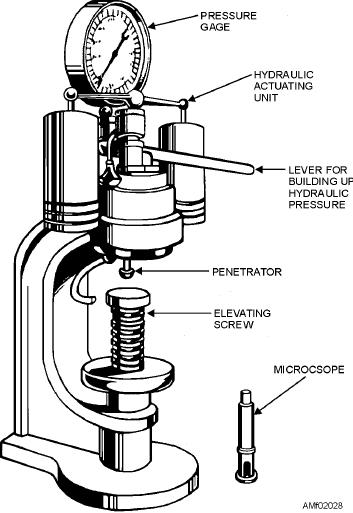
Q2-30.
At what temperature does aluminum alloy
become a liquid form?
Q2-31.
What term is defined as the eating away or
pitting of the surface or the internal structure
of a metal?
Q2-32.
What property allows two metals to be
welded, brazed, or soldered?
Q2-33.
What are the three basic metal working
processes?
Q2-34.
What type of metal contains iron as its
principal constituent?
Q2-35.
What are the two most commonly used
methods of hardness testing?
Q2-36.
What are the two classes of wrought alloys?
Q2-37.
What type of metal is used in the construction
of fire walls and fuselage skin adjacent to the
engine exhaust outlet?
HARDNESS TESTING
LEARNING
OBJECTIVES:
Identify
hardness testing methods. Identify related
testing equipments and their operation.
Hardness testing is a method of determining the
results of heat treatment as well as the state of a metal
prior to heat treatment. Since hardness values can be
tied in with tensile strength values and, in part, with
wear resistance, hardness tests are an invaluable check
Figure 2-28.--Brinell hardness tester.
of heat-treatment control and of material properties.
Practically all hardness testing equipment now in
service use the resistance to penetration as a measure of
hardness.
applied for 30 seconds. In order to produce equilibrium,
this period may be increased to 1 minute for extremely
TEST EQUIPMENT
hard steels. The load is applied by means of hydraulic
pressure. The hydraulic pressure is built up by a hand
Included among the better known bench-type
pump or an electric motor, depending on the model of
hardness testers are the Brinell and the Rockwell. Also
tester. A pressure gauge indicates the amount of
included are three portable type hardness testers--the
pressure. There is a release mechanism for relieving the
Riehle, the Barcol, and the Ernst--which are all being
pressure after the test has been made, and a calibrated
used by maintenance activities.
microscope is provided for measuring the diameter of
the impression in millimeters. The machine has various
Brinell Tester
shaped anvils for supporting the specimen and an
elevating screw for bringing the specimen in contact
The Brinell hardness tester, shown in figure 2-28,
with the ball penetrator. There are attachments for
uses a hardened spherical ball, which is forced into the
special tests.
surface of the metal. The ball is 10 millimeters (0.3937
To determine the Brinell hardness number for a
inch) in diameter. A pressure of 3,000 kilograms (6,600
metal, the diameter of the impression is first measured,
pounds) is used for ferrous metals and 500 kilograms
using the calibrated microscope furnished with the
for nonferrous metals. Normally, the load should be
2-34

